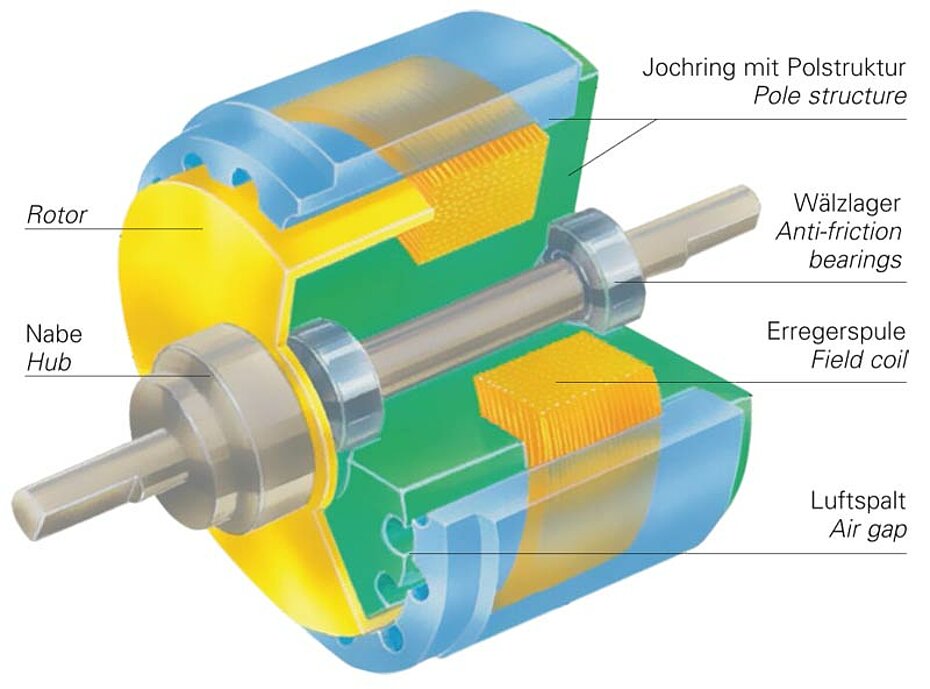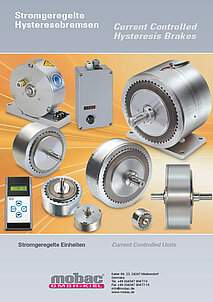Advantages
The superior design of these hysteresis devices provide several inherent advantages over magnetic-particle and friction devices. They operate on a frictionless design principle with virtually nor wear. This provides such advantages as: longer expected life, superior torque repeatability, life cycle cost advantages, broad speed range, excellent environmental stability and superior operational smoothness.
Operating principles
The hysteresis effect in magnetism is applied to torque control by the use of two basic components - a reticulated pole structure and a speciality steel rotor/shaft assembly - fitted together but not in physical contact. Until the pole structure is energized, the drag cup can spin freely on its shaft bearings. When a magnetizing force from either a field coil or magnet is applied to the pole structure, the air gap becomes a flux field and the rotor is magnetically restrained, providing a braking or clutching action between the pole structure and rotor.
Control
In an electrically operated hysteresis brake or clutch, adjustment and control of torque is provided by a field coil. This allows for complete control of torque by adjusting DC current to the field coil. Adjustability from a minimum value (bearing drag) to a maximum value of 15 - 35% above rated torque is possible. In a permanent magnet device, the field coil is replaced by a magnet which provides the precise field strength necessary to produce rated torque without the need of electrical excitation. Since the field strength produced by a permanent magnet is a constant value, the resulting torque will also be constant. Physical realignment of the pole structure will result in limited (but predictable) changes in torque. Special designs utilizing this method are available and will allow for adjustments down to approximately 30 - 40% of rated torque.
Longer expected life
Hysteresis brakes and clutches produce torque strictly through a magnetic air gap, making them distinctly different from mechanical-friction and magnetic particle devices. Because hysteresis devices do not depend on friction or shear forces to produce torque, they do not suffer the problems of wear, particle aging and seal leakage. As a result, hysteresis devices typically have life expectancies many times that of friction and magnetic particle devices.
Superior torque repeatability
Because torque is generated magnetically without any contacting parts or particles, hysteresis brakes and clutches provide superior torque repeatability. Friction and magnetic particle devices are usually subject to wear and aging with resultant loss of repeatability. Hysteresis devices will repeat their performance precisely, to ensure the highest level of process control.
Broad speed range
Hysteresis devices offer the highest slip speed range of all electric torque control devices. Depending on size, kinetic power requirements and bearing loads, many hysteresis brakes can be operated at speeds in excess of 10.000 rpm. In addition, full torque is available even at zero slip speed and torque remains absolutely smooth at any slip speed.
Operational smoothness
Because they do not depend on mechanical friction or particles in shear, hysteresis brakes are absolutely smooth at any slip ratio. This feature is often critical in wire drawing, packaging and many other converting applications.
Configurator
Our service to you:
with the >Questionair you can get more detailed information about our products.
>Type selection (PDF) and sizing
>Catalog Download (PDF)
for Current Controlled Hysteresis Brakes
(Size approx. 5MB)



